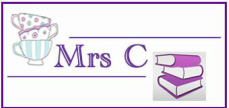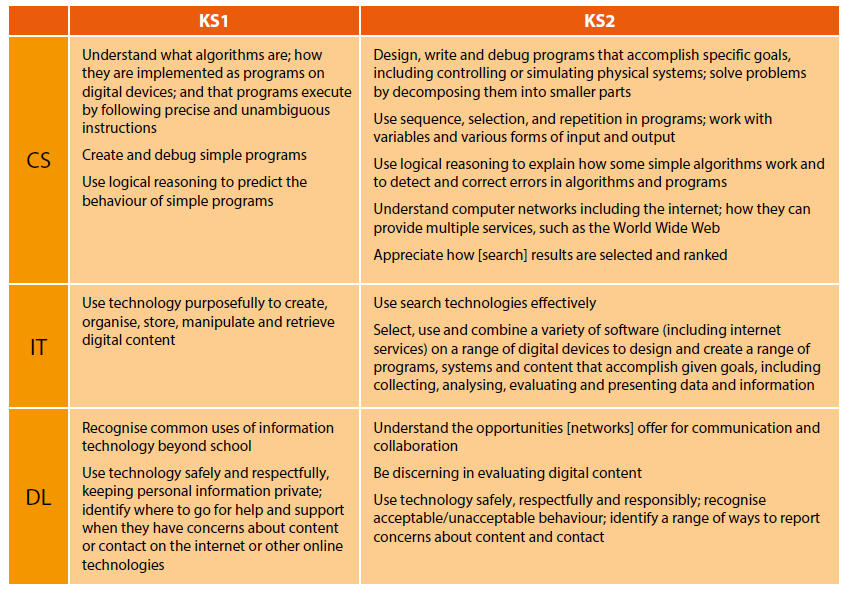What is computing?

Computing in the New Curriculum
September 2014 is a point of change for the primary curriculum and teaching. As a NQT in 2014 it is vital for me to keep up with the changes to the curriculum, especially with regard to ICT, as this is undergoing some vast changes and will become Computing in September 2014.
The new Computing National Curriculum can be downloaded by clicking on the button below.
September 2014 is a point of change for the primary curriculum and teaching. As a NQT in 2014 it is vital for me to keep up with the changes to the curriculum, especially with regard to ICT, as this is undergoing some vast changes and will become Computing in September 2014.
The new Computing National Curriculum can be downloaded by clicking on the button below.
Following the Ofsted report in 2008-2011, a summary report can be downloaded below, it was apparent that certain areas of ICT in education were lacking and fundamental aspects of computing were not being taught early on in schools. This was thought to have a detrimental impact on the future economy and thus decisions were made to make changes to the content of ICT and computing in schools.
The result was the new National Curriculum, which splits computing into three areas. These are information technology, computer science and digital literacy.
Computer science is concerned with the design of computers and how digital technology works. This aspect of the curriculum teaches children how to create technology and involves programming, debugging, computer networks, algorithms, and search engines. The emphasis is on the use of programmable toys such as Bee-Bots, logic activities, and real world applications.
Information Technology equips pupils with a range of skills which enables them to use different programs with confidence. For example, word processing, podcasts, blogging, video including animation, audio recording and media.
Digital Literacy involves being confident in the use of different information and communication technologies. The aim is to ensure pupils are competent and creative users of these technologies. The emphasis is that they are able to express themselves and develop their ideas using communication technologies at a level that enables them to be active participants in the digital world of today.
Download the document below with outlines a constructive account of the new curriculum.
Computer science is concerned with the design of computers and how digital technology works. This aspect of the curriculum teaches children how to create technology and involves programming, debugging, computer networks, algorithms, and search engines. The emphasis is on the use of programmable toys such as Bee-Bots, logic activities, and real world applications.
Information Technology equips pupils with a range of skills which enables them to use different programs with confidence. For example, word processing, podcasts, blogging, video including animation, audio recording and media.
Digital Literacy involves being confident in the use of different information and communication technologies. The aim is to ensure pupils are competent and creative users of these technologies. The emphasis is that they are able to express themselves and develop their ideas using communication technologies at a level that enables them to be active participants in the digital world of today.
Download the document below with outlines a constructive account of the new curriculum.
The programme of study for KS1 and KS2 proposed in the new curriculum is outlined in the table below. The expectations are that this content will be covered in schools from September 2014 in a creative manner.
This new approach to teaching computing in primary schools will enable a wider range of skills to be taught and the use of new technology. Now, rather than computing being seen as a tag on to other curriculum areas, it will be a subject of focus and there is strong emphasis on cross-curricular learning in the new curriculum that stresses that computing should also be used to enrich other subject areas. For example, literacy and blogging; or maths and Bee-Bots, there are numerous possibilities and as a NQT in September 2014, I intend on exploring these cross-curricular links to enrich the learning environment for children.
DISCLAIMER:
The author and creator is not responsible for any content which may be encountered on internet sites linked to this site, including any content pushed at you by sites like YouTube.
The author and creator is not responsible for any content which may be encountered on internet sites linked to this site, including any content pushed at you by sites like YouTube.


